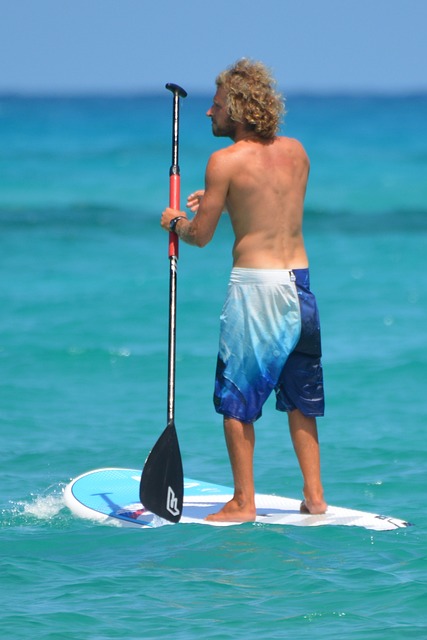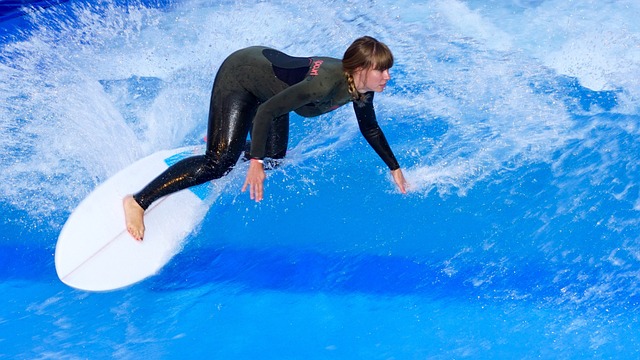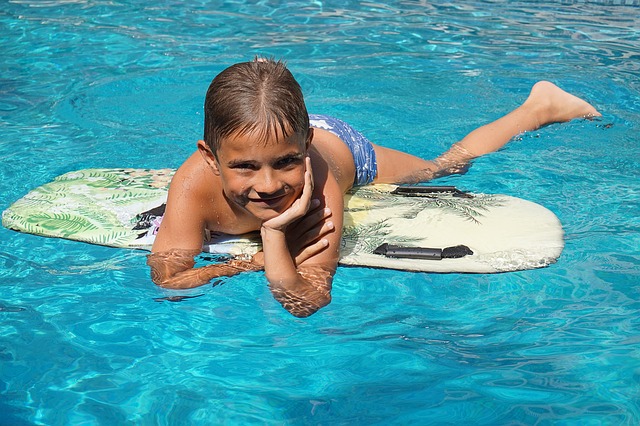surfboards made from lightweight foam core technology are ideal for beginners due to their buoyancy and ease of handling, which facilitate learning and reduce fatigue. These boards strike an optimal balance between durability and flexibility, ensuring new surfers can navigate the basics without worrying about damage or degradation. The right size for a beginner typically ranges from 7 to 9 feet in length, offering both floatation and control. Additionally, a single fin setup or a thruster configuration simplifies the learning process by providing a stable platform. For long-term care, rinsing with fresh water after each session and cleaning gently are essential maintenance practices to keep the board in top condition. Brands like BIC Sport and FCS offer beginner-friendly surfboards that combine stability, durability, and performance, making them great choices for those just starting out or looking to rent/purchase their first surfboard.
Exploring the world of surfing can be an exhilarating journey, and at its foundation lies the surfboard for beginners—the lightweight foam core. This article delves into the attributes that make these boards the ideal entry point into wave riding. We’ll cover their construction, key features that streamline learning, and how to select the perfect size and shape tailored for newcomers. Whether you’re navigating gentle swells or aspiring to master the basics, the advantages of a lightweight foam core surfboard are manifold, adapting to various conditions and providing the stability and ease needed to carve your path in the sport. Join us as we explore top brands that offer these beginner-friendly gems, ensuring your surfing experience is not only accessible but also enduring.
Understanding Lightweight Foam Core Surfboards: The Ideal Choice for Beginners

Lightweight Foam Core surfboards represent an excellent choice for beginners looking to explore the art of surfing. These boards are engineered with a dense foam core, sandwiched between two fiberglass layers, which provide a balance of stability and maneuverability necessary for newcomers to the sport. The lightweight nature of these boards allows for easier paddling and positioning, making it less taxing on a beginner’s muscles and energy levels. Additionally, the buoyancy afforded by the foam core ensures that even those who are not yet adept at catching waves can maintain their balance and have a more enjoyable learning experience. The durability of the fiberglass construction also means that these boards can withstand the inevitable bumps and dings that come with the learning curve, making them a cost-effective investment for anyone starting out in surfing.
Moreover, Lightweight Foam Core surfboards are designed with a soft, rubbery coating known as deck grip, which enhances the rider’s ability to stay on the board during the initial stages of learning. This feature, combined with the board’s forgiving nature, helps to build confidence in a safe and supportive manner. The boards also come in various shapes and sizes, accommodating different body types and surfing conditions, further adding to their versatility for beginners. Whether you’re seeking to ride small, gentle waves or gradually progress to more challenging surf, these lightweight foam core surfboards are an ideal starting point that can grow with your skills, ensuring a smooth transition as you advance in the sport.
Key Features of Foam Core Surfboards Enhancing the Learning Curve

For novice surfers, selecting the right equipment can significantly influence their learning curve and overall experience on the waves. Lightweight foam core surfboards are an optimal choice for beginners due to their accessible nature and performance attributes. These boards are designed with a high-density polyurethane foam core, encased in a durable composite wood skin, offering both lightness and strength. This construction ensures that the board is buoyant enough for those who may not yet have mastered balance, allowing them to paddle into waves more easily and with greater confidence. Additionally, the foam core reduces the physical strain on a learner’s body, making long days in the water less taxing. The lightweight nature of these boards also makes them manageable for beginners to handle both in and out of the water, which is crucial when mastering the basics of surfing.
The key features of foam core surfboards that enhance the learning curve include their forgiving nature and ease of use. These boards are typically wider and more stable, providing a platform that can accommodate the varying conditions beginners often encounter. The soft, impact-resistant foam core also means that if a beginner wipes out or encounters an unexpected wave, the board is less likely to sustain damage, which is both cost-effective and reduces the frustration that can accompany learning a new sport. Moreover, the consistent buoyancy and predictable performance of these boards mean beginners can focus on their technique rather than compensating for the board’s characteristics. This focused approach accelerates the learning process and helps build the confidence needed to progress from catching waves to attempting basic maneuvers.
Anatomy of a Foam Core Surfboard: Construction and Components

Lightweight foam core surfboards represent an accessible entry point into the world of wave riding, particularly for beginners. These boards are constructed with a high-density polyurethane foam core, encased within a composite of wood veneers or fiberglass cloth, which provides both strength and flexibility. The core contributes to the board’s buoyancy and ease of handling, making it an ideal choice for those new to surfing. The deck of the board is typically covered with a polyethylene laminate, offering durability and a non-slip surface that ensures riders maintain their footing even when conditions are less than ideal.
The stringer, often made from timber or carbon fiber, runs along the length of the board, adding structural integrity and channeling the flex patterns to enhance performance without overwhelming the user with advanced characteristics that can be found in more sophisticated designs meant for experienced surfers. The rails, or edges, are shaped to combine stability with maneuverability, a critical aspect for beginners learning to navigate and trim across waves. The fin setup is usually designed for simplicity and effectiveness, allowing novices to initiate turns with minimal effort. Overall, the construction of foam core surfboards caters to the needs of those just starting out, offering a reliable and forgiving platform from which to develop their skills in the exciting sport of surfing.
Selecting the Right Size and Shape for Beginner Surfers

When selecting a surfboard for beginners, it’s crucial to consider a size and shape that will provide stability and ease of paddling without compromising maneuverability. A lightweight foam core surfboard is an excellent choice for novices due to its buoyancy and forgiving nature. The right size typically ranges from 7 to 9 feet in length, offering both floatation and a more manageable board for learning the basics. Additionally, beginner surfers should opt for a thicker board, which not only adds extra floatation but also softens the impact when catching waves or falling into the water.
The shape of the surfboard is equally important for beginners. A wide outline allows for greater stability, making it easier to maintain balance while standing up and riding a wave. Longboards and mini-mals are popular among those new to surfing due to their length-to-width ratio, which contributes to a smoother ride and easier wave entry. For beginners, a single fin setup or a thruster (three fins) can be beneficial as it simplifies the process of trimming and turning on the wave face. This setup also provides a stable platform for developing skills without the complexity of advanced fin configurations.
The Advantages of Lightweight Foam Core Boards in Various Conditions

Lightweight Foam Core boards have become a staple in the world of surfing, particularly for beginners. Their design offers a range of benefits that make them suitable for various conditions and environments. The first advantage is their reduced weight, which allows novices to paddle into waves with ease, without the fatigue associated with heavier boards. This lightness also means that the boards are more manageable when carrying them to and from the water, a significant factor for those just starting to learn the sport.
Moreover, these boards are constructed with a core of polyurethane foam encased in a composite skin, which provides a balance between durability and flexibility. This construction ensures that beginners can experiment with different positions and movements without fear of causing significant damage to their board. The foam core also offers excellent buoyancy, keeping the rider afloat and stable, which is crucial for learning the fundamentals of surfing. Additionally, the consistent performance of these boards across a variety of wave conditions makes them an adaptable option for those developing their skills. Whether it’s small, gentle waves or slightly larger swells, Lightweight Foam Core boards are designed to deliver a positive and progressive surfing experience for beginners.
Mastering the Basics with a Foam Core Surfboard: Tips and Techniques

A surfboard crafted from lightweight foam core serves as an ideal platform for beginners to master the fundamentals of surfing. Its buoyancy and manageable weight make it user-friendly, allowing novices to focus on developing their skills without being overwhelmed by the demands of the board. To effectively utilize a foam core surfboard, start by selecting a board that’s appropriate for your weight, height, and skill level; this ensures optimal performance and safety. Paddling techniques are crucial in catching waves, and beginners should practice frog paddles to build strength and improve their ability to read waves. Positioning on the board is also vital—lie centrally to maintain balance and avoid placing undue pressure on the rails. As you pop up onto your feet, align your chest over the center of the board for stability. Popping up involves a swift yet fluid motion: hands beside your hips, feet hip-width apart in the center of the deck, and knees bent slightly. This foundational movement sets the stage for successful wave riding and should be practiced regularly to build muscle memory.
Once you’ve mastered the pop-up, focus on your stance. A strong standing position is characterized by a wide base with your feet parallel to the stringer, which provides a solid foundation and helps with steering. Keep your knees slightly bent to maintain flexibility and balance. Your upper body should remain relaxed yet upright, with arms out for balance rather than reaching for the wave. As you gain confidence, experiment with different surfing maneuvers on flat days to enhance your skill set. Remember to always be mindful of your surroundings, other surfers, and ocean conditions. With patience, practice, and a quality foam core surfboard, mastery of the basics will lead to a rewarding and enjoyable surfing experience.
Maintenance and Care for Your Foam Core Surfboard to Ensure Durability

Maintaining and caring for your foam core surfboard, particularly one designed for beginners, is crucial for its longevity and performance. To ensure your board remains in top condition, regular maintenance is necessary. Begin by rinsing your surfboard with fresh water after each use to remove saltwater, sand, and any other abrasive substances that can accelerate degradation. Using a soft brush or sponge, gently clean the deck (the top of the board) and the rail (the edge) with a mild detergent solution. Be careful around the fin boxes and avoid using harsh chemicals or abrasive pads that could damage the sensitive foam core material.
For more in-depth cleaning, consider using a surfboard wax residue remover to clean the deck effectively without compromising the traction pad’s grip. Store your board in a cool, shaded area, away from direct sunlight and extreme temperatures, which can weaken the foam over time. If dings or minor repairs are needed, use a repair kit specifically designed for foam core boards. Dings can compromise the integrity of the board, so address them promptly to maintain the structural soundness of your beginner’s surfboard. Regular inspection and timely maintenance will help you enjoy your surfboard for many sessions to come.
Top Brands Offering High-Quality Lightweight Foam Core Surfboards for Beginners

Lightweight foam core surfboards represent an excellent choice for beginners looking to navigate their initial forays into the sport. These boards offer a balanced blend of buoyancy and maneuverability, making them user-friendly for those who are new to catching waves. Among the top brands that stand out for providing high-quality options suitable for novices are BIC Sport and FCS. BIC Sport’s range of softboards, such as the Dura-Teck series, is designed with a lightweight foam core that ensures stability and durability without compromising on ease of use. This makes them ideal for learning the basics without the fear of getting knocked around by heavy boards in choppy waters.
Another reputable brand is FCS, known for its performance softboards. Their approach to crafting surfboards for beginners focuses on a light and lively feel, ensuring a responsive ride that still provides the necessary floatation for those new to standing up on a board. These surfboards are often equipped with features like a soft deck for comfort and a three-fin setup that helps with steering and stability. Both BIC Sport and FCS have earned a reputation for quality in their foam core surfboards, providing beginners with gear that supports growth as they progress in their surfing skills. Whether you’re looking to rent or purchase your first board, these brands are synonymous with reliability and performance in the beginner surfboard market.
